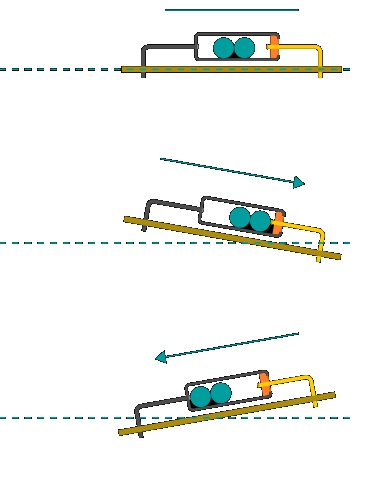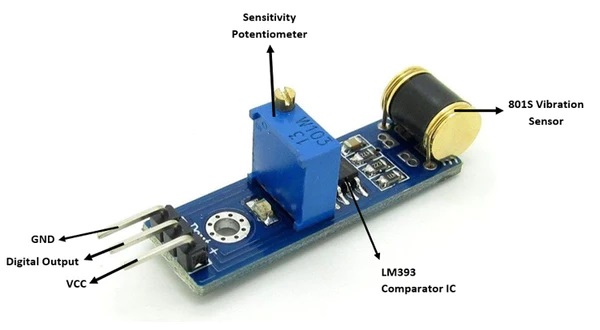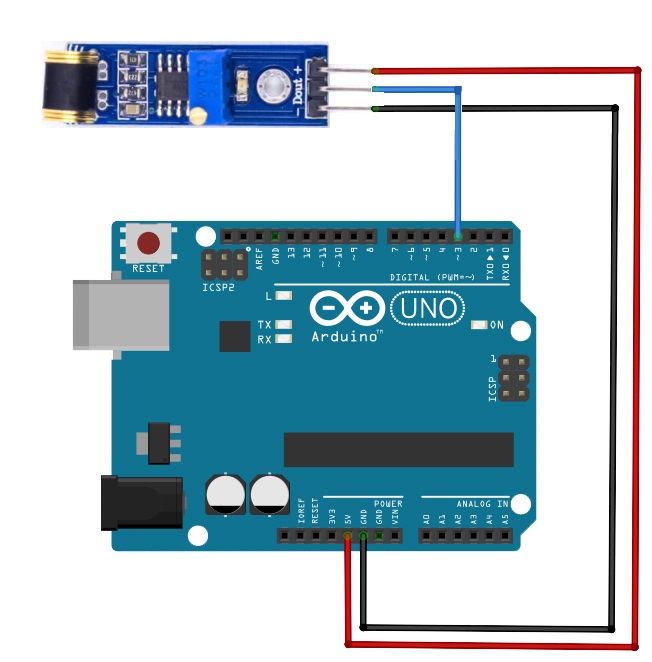AED 30.45
Description
The 801S shock and vibration sensor, When subjected to vibrations, changes resistance. The resistance changes are so drastic that the 801S acts as a switch. The device is made of gold and can resist 60 million shocks. The 801S, like most resistance-varying devices, is coupled to a voltage divider circuit to produce a voltage output.
Package Includes:
- 1 x Tilt Module 3pin 801s Vibration Sensor
Features:
- Supply voltage:3.3V-5V
- On-board LM393 Comparator IC
- The comparator output sensitivity can be changed with the help of a potentiometer.
- Output form: digital switch output (0 and 1)
- Has a fixed bolt-hole for convenient installation
Description:
Like most resistance-varying devices, the 801S shock and vibration sensor is connected to a voltage divider circuit to produce a voltage output. Resistance changes when subjected to vibrations. The resistance variations are so extreme that the 801S works as a switch. The gold-plated device can withstand 60 million shocks. The 801S vibration sensor module has a digital output pin that outputs HIGH when vibration is detected up to a specific threshold. A potentiometer on the module can be used to alter the sensitivity of this sensor. This module's integrated circuit (IC) is LM358. This module is used in security systems.
Principle of Work:
The Tilt sensor, model 801s, is a sensitive switch with two balls inside. It can be used both for the tilt function (horizontal position) and for the vibration function (vertical position). Based on the vibrations and external impulses supplied to it, the vibration sensor module generates logic-level outputs. That is, if there is no vibration, the output remains in the logic-low (L) state. However, during a vibration detection, the output state briefly switches to the logic-high (H) level.

for more information, This board includes an LM393 op-amp IC (used as a comparator) and a trimmer for adjusting the sensitivity. DOUT, +, and - are the three pins. The board requires 5V power, which should be connected to the + and - pins. The DOUT pin generates a TTL signal that correlates to the 801S's vibration.
Pinout of the Module:

|
Pin |
Description |
|
VIN |
The Vcc pin powers the module, typically with +5V |
|
GND |
Power Supply Ground |
|
OUT |
Digital Out Pin for Digital Output. |
LM393 IS
In this vibration sensor module, an LM393 Comparator IC is employed as a voltage comparator.
Preset (Trimmer pot)
You can change the threshold (sensitivity) of the digital output using the onboard preset.
Vibration Switch 801S
The amplitude of the vibration to which it is exposed is recognized by the vibration switch. The switch response might be either an electrical contact closure or an electrical contact opening.
Applications:
- theft alarm
- intelligent car
- earthquake alarm
- motorcycle alarm
Circuit:
The D13 pin is where the ON-board LED is linked. The Arduino's available 5V pin is used to power the module. The Arduino is powered by the Ground and 5V pins, and the data from the vibration sensor is obtained using the pin3.

Library:
No Library is needed for this module to function
Code:
When the vibration sensor is engaged or if its status changes, the led is observed. When there are vibrations, the led linked to Arduino UNO Pin 13 will blink. Check the connection and power if the vibration sensor isn't working. Keep the connection between the sensor and the microcontroller tight.
#include "stdio.h"
#define ON 1
#define OFF 0
int vibration_Sensor = 3;
int LED = 13;
int present_condition = 0;
int previous_condition = 0;
void setup() {
pinMode(vibration_Sensor, INPUT);
pinMode(LED, OUTPUT);
}
void led_blink(void);
void loop() {
previous_condition = present_condition;
present_condition = digitalRead(A5); // Reading digital data from the A5 Pin of the Arduino.
if (previous_condition != present_condition) {
led_blink();
} else {
digitalWrite(LED, OFF);
}
}
void led_blink(void) {
digitalWrite(LED, ON);
delay(250);
digitalWrite(LED, OFF);
delay(250);
digitalWrite(LED, ON);
delay(250);
digitalWrite(LED, OFF);
delay(250);
}
Technical Details:
|
Type of sensor
|
vibration |
|
Operating temperature
|
-40...220°C |
|
Sensors features
|
detect motion or vibration |
|
Body dimensions
|
Ø7x9.15mm |
| Operating lifespan: | above 60000000 circle |
Resources:
Comparisons: